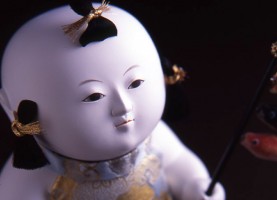

災厄を身代わりしてくれるものとして、また愛玩用として日本人の生活に深いかかわりを持ってきた人形。京人形は、平安時代(8 末~12 世紀)、貴族の子供たちの遊び道具であった「ひいな人形」がその起源だといわれ、今日では、浮世人形、雛人形、五月人形、御所人形、市松人形など多くの種類が作られています。頭、髪付け、手足、小道具、着付(雛人形)などに製造工程が分業化されているのが特徴です。技術の高さと、細部まで丁寧に仕上げる伝統が高く評価されています。
Dolls have long been used in Japanese life both as toys and as talismans which deflect misfortune from the owner. Kyoto dolls are said to have originated in the hina dolls that were toys of aristocrats' children during the Heian Period from 8th to 12th centuries. Today, they include a wide range of doll types. For example, ukiyo dolls, dolls representing female commoners, made so the kimono hem can be lifted, hina dolls, representing the imperial retinue for the Girls' Festival, gogatsu dolls, for the Boys' Festival, gosho dolls, ceramic dolls of corpulent boys, and ichimatsu dolls which made from molded sawdust, named for their resemblance to Sonogawa Ichimatsu, an 18th century kabuki actor. Hina dolls in particular are made by numerous artisans who fabricate specific components such as the heads, hairstyles, hairstyles, hands and feet, accessories, and clothing. They are widely known for their technical skill and tradition of attention to fine detail.
十九代を数える老舗京人形の店が
宮中の美意識を再現した創作・皇宮雛
A Kyoto dollmaker’s studio established for 19 generations re-creates the aesthetics of Heian courtly life with its “Hina” dolls.
いきいきした着物のひだと髪
生きているようなリアルな時代人形
With dynamic kimono pleats and hair-styles,
these period dolls appear to be almost alive.
歴史は1000年以上昔から
宮中で生まれた優雅で愛らしい御所人形
Elegant Gosho dolls: born in the Heian court and beloved for a thousand years.
本金箔を使った優美な京甲冑
小さな人形に表現された武者の誇り
A miniature set of elegant armour trimmed with real gold-leaf, expresses the pride of the warrior.






